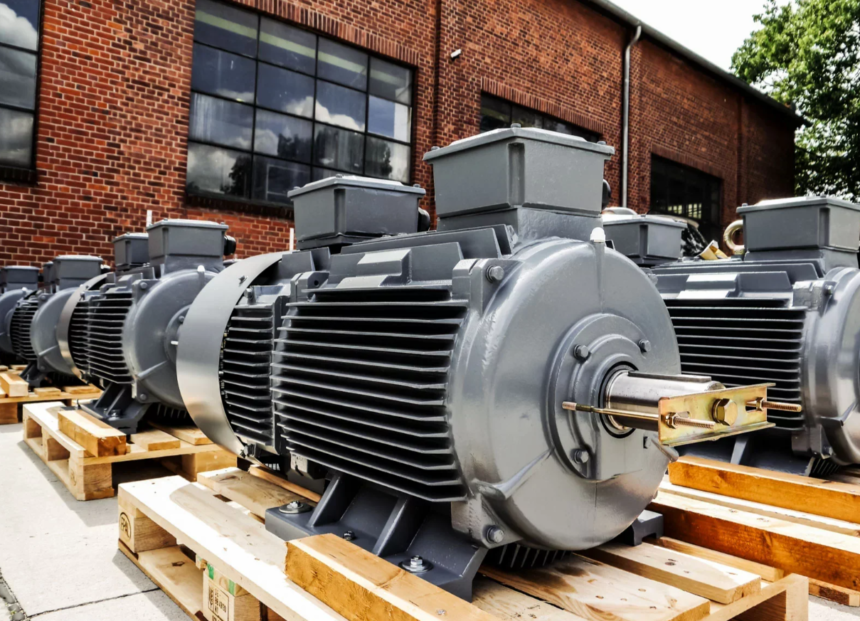In the sprawling landscape of modern industry, the slip ring induction motor stands out as a cornerstone of engineering achievement. These motors power everything from lifts in construction sites to the mixers in your favorite bakery, demonstrating their relevance and versatility across various sectors. This guide unfolds the layers of slip ring induction motors, revealing why they remain pivotal in contemporary industrial operations.
Exploring the Slip Ring Induction Motor
Understanding the nuance and subtlety of slip ring induction motors calls for digging beneath the surface and exploring their unique attributes and the significance of their component configuration, as illustrated by diagrams.
What Makes Slip Ring Induction Motors Unique
Defining the uniqueness of slip ring induction motors requires us to step into the realm of rotor construction and power control. At the outset, these motors bear resemblance to their counterparts—squirrel cage induction motors—but lurking beneath the surface are distinguishing features that give slip ring motors their identity.
Unlike other motor types, slip ring induction motors are built with an external rotor circuit. This is achieved by mounting three slip rings on the motor shaft. Each of these rings is connected to one of the three phases of the rotor windings. This unique configuration facilitates the introduction of variable external resistance, something that remains elusive with squirrel cage motors.
The ability to add variable resistance is instrumental in controlling power output, allowing for higher starting torque and smoother acceleration—traits vital for heavy-duty applications. Moreover, this characteristic empowers slip ring motors with adjustable speed capabilities, offering a high degree of control that is pivotal in applications where speed regulation is paramount.
Diagram Interpretation and Significance
Delving into the blueprint of a slip ring induction motor proves illuminating, revealing a symphony of components meshing together. Diagrams typically offer a cross-sectional view of these motors, with various parts like the stator, rotor, and of course, the slip rings carefully demarcated.
The three slip rings—aligned on the rotor’s shaft—stand out due to their distinctive construction. Connected to these rings are “brushes” that slide over the rings, allowing external resistances to be introduced into the rotor circuit. The significance of these rings is amplified when the concept of variable external resistance is examined, which is central to the control and operational dynamics of these motors.
More than just a visual aid, a well-drawn slip-ring induction motor diagram is an illustrative narrative of engineering ingenuity. It offers an unrivaled understanding of the motor’s operation dynamics, the role of each component, and the delicate balance they maintain for effective function.
Slip Ring Induction Motors Components Breakdown
Like a well-orchestrated symphony, slip ring induction motors consist of various components working in harmony to create the power that continues to fuel industries across the globe. A closer look into these components not only provides a clearer understanding of their functions but also emphasizes the importance of each part, with the slip rings playing a vital role.
Detailed Dive into Motor Components with Emphasis on Slip Rings
Each component in a slip ring induction motor, from the external casing to the ever-crucial slip ring, plays a distinct role in the unit’s operation. To truly understand the mechanics of these motors, let’s dissect the motor and examine its parts:
- Stator: The stator, or the stationary part, of the motor, is composed of a casing that houses the stator windings. These windings are fed by a three-phase alternating current, which produces a rotating magnetic field.
- Rotor: The rotor, the revolving part of the motor, comprises a set of windings where the stator’s rotating magnetic field induces current. A distinguishing feature here is the arrangement of its end windings, which are connected to the slip rings.
- Slip Rings and Brushes: Quite possibly the stars of the show—the slip rings are circular conducting materials fixed to the rotor assembly, each connected to one phase of the rotor winding. Carbon brushes, which have a sliding contact with the slip rings, facilitate the introduction of external resistances into the rotor circuit.
The unique ability to introduce external resistance renders these motors adaptable and adjustable in their functionality, marking their significance in motor operations.
Description and Function of Each Component
The Stator comprises windings arranged in a specific pattern to generate a three-phase magnetic field, which is foundational to the induction process.
The Rotor plays the recipient of the magnetic field induced by the stator. The windings here are on the receiving end of the induced current, which generates a secondary magnetic field.
The Slip Rings and Brushes constitute a crucial link essential for tuning motor performance. The slip rings serve as conduits that allow changes in the rotor circuit’s resistance, while the brushes keep the electrical contact between the stationary and rotating parts.
Understanding these components and their functions is an enlightening narrative of engineering artistry, shedding light on why these motors have steadily cemented their role in the industrial landscape. As we journey further into the motor’s heart, we come to appreciate the design ingenuity and the perfect synchronization of components, which contribute to the powerhouse that a slip ring induction motor represents.
Formulae Essential for Understanding Slip Ring Induction Motors
To fully comprehend the operation and behavior of slip ring induction motors, it is imperative to have at hand certain mathematical principles and formulae. These equations are critical to analyzing parameters such as efficiency, torque, speed, and power, which bear a direct impact on the motor’s overall performance. Practical examples help demystify these mathematical expressions, bringing them to life in real-world scenarios.
Introduction to Key Mathematical Formula Related to Performance and Efficiency
The following represents some of the key mathematical constants and derivatives required for a comprehensive understanding of the performance and efficiency of slip ring induction motors:
- Slip (S): Commonly represented as s, slip is the degree of speed variation between the synchronous speed and the motor’s actual speed. It can be computed with the formula S = (Ns – N) / Ns, where Ns denotes the synchronous speed, and N is the actual speed.
- Rotor Current: The rotor current (Ir) and its phase angle can be deciphered utilizing a formula involving the slip (s), the standstill rotor resistance (R2), and the standstill leakage reactance (xl2).
- Torque (T): The torque generated by the motor is closely tied to the motor output power (Pout) and is calculated as T = Pout / (2πN / 60), where N is the motor speed.
- Efficiency (η): Naturally, one of the most important parameters is the motor’s overall efficiency, calculated using the formula η = Pout / Pin, where Pin signifies the input power.
Grasping these key formulae and their variables is crucial when discussing performance, optimization, troubleshooting, and overall understanding of slip ring induction motors, bridging the gap between theoretical concepts and practical engineering outcomes.
Practical Examples to Illustrate the Application of These Formulas in Real-World Scenarios
Understanding these formulas through practical real-world examples can dispel the aura of complexity that often surrounds these mathematical expressions:
- Calculating slip is essential when trying to understand if the motor is operating at optimal speed. For instance, if a motor’s synchronous speed is 1500 RPM and it is running at 1470 RPM, the slip is (1500-1470)/1500 = 0.02 or 2%.
- Determining the torque of slip ring motors is vital when deciding the appropriate motor for a machine that requires a substantial amount of starting torque, such as a conveyor belt or a crane. By examining the motor’s output power and speed, you can calculate the torque and select the right motor for the job.
- An efficiency calculation is imperative when auditing a plant’s energy consumption. For instance, if a slip ring motor consumes 10KW to deliver an output power of 8KW, the efficiency of the motor would be 8/10 = 80%.
Interpreting these mathematical expressions and the associated real-world implications enables users to make informed decisions about the selection, operation, and upkeep of slip ring induction motors. It empowers them to foster better energy practices, improve system efficiency, and align their understanding with the dynamic industrial landscape.
The Operation of Slip Ring Induction Motors
The fascinating world of slip ring induction motors is a myriad of intricate designs and sophisticated operation principles. An in-depth exploration into how these motors work unveils a rich tapestry of engineering excellence, where every component plays a pivotal role in the overall functionality. Central to this exploration is the motor’s unique 3-phase slip ring induction architecture, a key to its versatile performance characteristics.
Detailed Explanation of How These Motors Work
The operation of slip ring induction motors is predicated on the fundamental principles of electromagnetic induction and interaction. At the core of these motors is a robust design facilitating controlled starting currents and adjustable speed capabilities, distinguishing them from their squirrel cage counterparts.
The slip ring induction motor operates on the principle that a 3-phase current flowing through the stator windings produces a rotating magnetic field. This magnetic field is key to the motor’s operation as it induces a current in the rotor windings, thereby creating a secondary rotating magnetic field.
The rotor is comprised of wound windings, laid out in such a manner that they create closed loops. These windings are connected to the outer world via the slip rings. Herein lies the vital architectural difference – these slip rings, along with adjustable resistors connected to them, enable control over the motor’s reaction to load by influencing the rotor current.
As the load on the motor increases, more current is drawn to maintain torque. This inherently increases the slip, or the difference between the rotor speed and the synchronous speed of the rotating magnetic field. By adjusting the resistance in the rotor circuit through the slip rings, it’s possible to control the motor’s speed, startup torque, and current, providing a soft start and variable speed under different loads.
Working Principle with a Focus on the Importance of the 3-Phase Slip Ring Induction Architecture
The 3-phase slip ring induction architecture stands out for several reasons. Firstly, it embraces the three-phase power supply to its advantage, utilizing it to generate a self-starting rotating magnetic field. This rotating field interacts with the rotor in a way that significantly reduces the inrush of current associated with motor starts.
The allocation of three slip rings also directly impacts the capability to manage how the motor responds to varied loads. By manipulating the resistance across these rings, operators can fine-tune the motor’s electrical and mechanical characteristics. This adaptability is crucial in applications requiring precise control over starting conditions, such as in elevators or heavy lifting equipment, where jarring starts and stops can lead to mechanical stress.
Furthermore, the presence of the slip ring mechanism allows for more efficient handling of high starting torques and load fluctuations, providing smoother operation and reducing wear on the system. This nuanced control over the motor’s behavior under different operational scenarios underscores the importance of the 3-phase slip ring induction architecture in industrial applications.
In summary, slip ring induction motors exemplify an elegant engineering solution to the complex requirements of high-torque and variable-speed applications. The 3-phase slip ring architecture is not just an incremental feature but is central to the motor’s functionality, providing unparalleled control and efficiency in challenging industrial environments.
Slip Ring Induction Motors Speed Control and Its Impact
The ingenuity of slip ring induction motors extends beyond their basic functionality, diving into the realms where speed control becomes an art as much as it is a science. Controlling the speed of these motors not only improves process efficiency but also significantly extends the lifespan of the motor by reducing mechanical stress. The methods for adjusting the motor’s speed, ranging from adding external resistances to sophisticated electronic control systems, highlight the versatile nature of these motors.
Dissecting the Methods for Adjusting the Motor’s Speed
The primary method of controlling the speed of slip ring induction motors involves the manipulation of resistance in the rotor circuit. Given the unique construction of these motors with slip rings and brushes providing an electrical connection to the rotor windings, adjusting the circuit’s resistance directly impacts the rotor current and, consequently, the motor’s speed. This method offers a straightforward approach to speed control, particularly beneficial during start-up and in applications necessitating variable speeds.
Another influential method involves changing the supply frequency. With the advent of variable frequency drives (VFDs), controlling the speed of slip ring induction motors has become more efficient and precise. By altering the frequency of the electrical supply, the speed of the rotating magnetic field in the stator changes, allowing for a smooth and controlled adjustment of the rotor speed.
A less common but potentially effective method is pole changing. This method requires winding the motor in such a way that, by rearranging the connections, the number of magnetic poles in the motor is altered, which in turn changes the synchronous speed of the motor.
Detailed Examination of Speed Control Methods: Theoretical and Practical Aspects
- Adding External Resistances: The theoretical basis of this method relies on Ohm’s law and the slip characteristics of induction motors. By increasing the resistance in the rotor circuit, the slip increases without a significant loss in torque. This method is practically applied using rotor rheostats, which are connected through the slip rings and brushes, allowing for fine-tuned control over the motor speed. It’s particularly useful in heavy industries where high starting torque and controlled acceleration are necessary.
- Variable Frequency Drives (VFDs): The use of VFDs represents a modern approach to motor speed control, leveraging the relationship between the motor’s speed and the frequency of the supply current. Theoretically, this method alters the speed by changing the frequency of the rotating magnetic field, thus affecting the speed at which the motor operates. Practically, VFDs are increasingly common due to their precision, energy efficiency, and the added benefit of reducing the electrical stress on the motor during start-up.
- Pole Changing: Theoretically, this method takes advantage of the fact that the motor’s synchronous speed is a function of the supply frequency and the number of magnetic poles in the motor (Ns = 120f/P). By changing the number of poles, one can alter the synchronous speed. In practice, pole changing is implemented through specially designed motors that allow for the reconfiguration of the stator winding connections. While effective, the complexity and higher cost of such motors limit their use to specific applications requiring multiple, distinct speed settings.
The impact of implementing these speed control methods extends beyond operational efficiency and into the realm of energy conservation and equipment longevity. By allowing for precise control over motor speed, these methods enable operations to match motor performance with the exact requirements of each task, minimizing energy waste and reducing the wear and tear on mechanical components. The evolution of speed control technologies continues to enhance the adaptability of slip ring induction motors, cementing their status as invaluable assets in modern industrial applications.
Slip Ring Induction Motors Manufacturers and Market Leaders
The landscape of slip ring induction motor manufacturing is dotted with veterans and innovators alike, each bringing their unique blend of tradition, technological expertise, and forward-thinking to the industry. As pivotal components in various applications ranging from heavy machinery to renewable energy setups, the demand for these motors ensures a competitive market. Leading manufacturers have established themselves not only through the longevity and reliability of their products but also through a continuous commitment to innovation and customer satisfaction.
Overview of Leading Slip Ring Induction Motor Manufacturers
Among the giants, companies like Siemens, ABB, and Schneider Electric stand tall, boasting a wide array of industrial electric motors, including slip ring induction motors. These manufacturers are known for their robust research and development efforts, resulting in motors that are highly efficient, durable, and capable of operating under the most demanding conditions. Their global presence and comprehensive after-sales services further cement their status as market leaders.
Emerging alongside these titans are specialized manufacturers like WEG and TECO-Westinghouse, which have carved niches for themselves by focusing on specific industrial needs and innovative solutions, such as energy-saving designs and integration with modern smart grid systems. These companies are quickly becoming synonymous with high-performance and environmentally friendly motor solutions, appealing to a market increasingly concerned with sustainability.
Innovation Patterns and What to Look for in a Manufacturer
Innovation in the slip ring induction motor market is propelled by the dual demands of energy efficiency and operational flexibility. Manufacturers leading in innovation often showcase patterns such as:
- Integration with Digital Technologies: The adoption of IoT (Internet of Things) capabilities for predictive maintenance, performance monitoring, and operational optimization is a key trend. Look for manufacturers that provide smart motor solutions, capable of integration into larger digital management systems.
- Advances in Materials and Design: Innovations in electromagnetic steel, insulation materials, and cooling systems contribute significantly to the efficiency and lifespan of motors. Manufacturers at the forefront of these advancements offer motors that are not only more energy-efficient but also smaller and lighter without compromising on power.
- Sustainability Initiatives: With a global push towards greener technologies, leading manufacturers are investing in research to make their motors more eco-friendly. This includes everything from reducing the carbon footprint of their manufacturing processes to designing motors that operate more efficiently and utilize recyclable materials.
When selecting a manufacturer for slip ring induction motors, it is crucial to consider not only the product specifications but also the company’s track record in innovation, customer support, and sustainability practices. Look for manufacturers that are not just selling a product but are offering a partnership to address your specific needs. This could manifest in the form of customizable motor designs, extensive after-sales services, and technical support, ensuring that your investment is protected and supported throughout its lifecycle.
Slip Ring Induction Motors Common Queries Answered
Slip ring induction motors, with their complex functionality and diverse applications, often prompt a wide range of questions from professionals and enthusiasts alike. Understanding these motors’ operational nuances is essential for optimizing their use in various industrial scenarios. Below, we delve into some of the most frequently asked questions about slip ring induction motors, providing comprehensive answers that blend technical insight with practical advice.
Addressing Frequently Asked Questions about Slip Ring Induction Motors
- How do slip ring induction motors differ from squirrel cage motors?
Slip ring induction motors differ mainly in their rotor design. Unlike squirrel cage motors that have a fixed rotor resistance, slip ring motors feature wound rotors connected to the external circuit through slip rings. This design allows for the adjustment of the rotor’s resistance, offering controlled starting currents, reduced startup torque, and the capability for variable speed control, making them ideal for applications requiring these specific characteristics. - Why are slip ring motors used despite being more complex than their counterparts?
The primary advantage of slip ring induction motors is their ability to provide high torque with a controlled starting current and the capacity for speed adjustment. These features make them indispensable in industries where heavy loads need to be started with minimum electrical stress or where variable speed is a necessity. Their complexity is often justified by the operational flexibility and efficiency they lend to demanding applications. - How can the speed of a slip ring induction motor be controlled?
Speed control in slip ring induction motors is achieved by introducing variable resistances in the rotor circuit through the slip rings. By adjusting these resistances, one can control the slip of the motor, thereby varying its speed. Additionally, modern methods include the use of variable frequency drives (VFDs) that alter the motor’s input frequency, providing precise speed control without changing the rotor resistance.
Insight into Practical Challenges and Solutions in Working with Slip Ring Induction Motors
Working with slip ring induction motors presents unique challenges, from maintenance issues related to the slip rings and brushes to the precise control of rotor resistance for optimal performance. Addressing these challenges requires a blend of preventive maintenance strategies and technological solutions.
- Maintenance of Slip Rings and Brushes: Regular maintenance is crucial for the longevity and efficiency of slip ring motors. The slip rings and brushes, being in constant physical contact, are prone to wear and tear. Ensuring that these components are routinely checked, cleaned, and replaced when necessary can prevent motor failure and downtime.
- Controlling Rotor Resistance: Precisely controlling the rotor resistance for specific applications can be challenging, especially in older systems lacking modern control technologies. Retrofitting slip ring motors with variable frequency drives (VFDs) can offer a more refined control over motor speed, reducing reliance on manual adjustments and improving operational efficiency.
- Dealing with Insulation and Cooling Issues: Given the high starting torques and variable speeds, slip ring motors can be susceptible to overheating and insulation stress. Implementing proper cooling systems, choosing motors with advanced insulation materials, and regular monitoring of motor temperature can mitigate these issues.
In conclusion, while slip ring induction motors are indispensable in various industrial applications due to their unique capabilities, they also present specific challenges. Addressing these challenges through regular maintenance, technological upgrades, and a deep understanding of motor operation is key to harnessing their full potential. Whether for a seasoned engineer or an industry newcomer, grasping the intricacies of slip ring induction motors is a step towards optimizing industrial processes and achieving operational excellence.
Slip ring induction motors embody a blend of tradition and innovation, offering a glimpse into the past of electrical engineering while propelling us into the future. This guide has traversed the intricacies of these motors, laying bare their design, operation, and control. As we close this journey, we encourage readers to continue exploring, armed with the knowledge and resources provided to delve even deeper into the world of slip ring induction motors.















